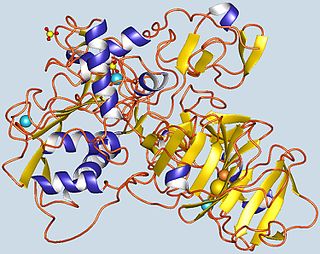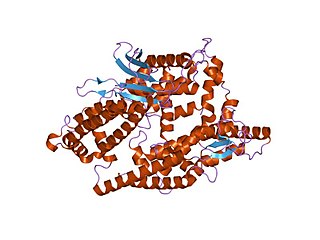Related Research Articles
A metalloproteinase, or metalloprotease, is any protease enzyme whose catalytic mechanism involves a metal. An example is ADAM12 which plays a significant role in the fusion of muscle cells during embryo development, in a process known as myogenesis.

Gelatinase A, also known as MMP2 is an enzyme. This enzyme catalyses the following chemical reaction

Met-enkephalin, also known as metenkefalin (INN), sometimes referred to as opioid growth factor (OGF), is a naturally occurring, endogenous opioid peptide that has opioid effects of a relatively short duration. It is one of the two forms of enkephalin, the other being leu-enkephalin. The enkephalins are considered to be the primary endogenous ligands of the δ-opioid receptor, due to their high potency and selectivity for the site over the other endogenous opioids.

Prolyl endopeptidase (PE) also known as prolyl oligopeptidase or post-proline cleaving enzyme is an enzyme that in humans is encoded by the PREP gene.

Neuromedin N is a neuropeptide derived from the same precursor polypeptide as neurotensin, and with similar but subtly distinct expression and effects. Composed of the amino acid sequence Lys-Ile-Pro-Tyr-Ile-Leu, neuromedin N is homologous to neurotensin, both of whose sequences are found on the pro neurotensin/neuromedin N precursor C-terminus. Both sequences of neuromedin N as well as neurotensin are flanked by Lys-Arg amino acids, which comprise a consensus sequence for the endoprotease proprotein convertase. Neuromedin N is primarily synthesized in the neural and intestinal tissues of mammals; in studies performed in mice, neuromedin N's physiological effects were shown to include hypothermia and analgesia, arising from the peptide's ligand association to and interaction with neurotensin type 2 (NTS2) G protein-coupled receptors.
Kexin is a prohormone-processing protease, specifically a yeast serine peptidase, found in the budding yeast. It catalyzes the cleavage of -Lys-Arg- and -Arg-Arg- bonds to process yeast alpha-factor pheromone and killer toxin precursors. The human homolog is PCSK4. It is a family of subtilisin-like peptidases. Even though there are a few prokaryote kexin-like peptidases, all kexins are eukaryotes. The enzyme is encoded by the yeast gene KEX2, and usually referred to in the scientific community as Kex2p. It shares structural similarities with the bacterial protease subtilisin. The first mammalian homologue of this protein to be identified was furin. In the mammal, kexin-like peptidases function in creating and regulating many differing proproteins.

Tripeptidyl-peptidase 2 is an enzyme that in humans is encoded by the TPP2 gene. Among other things it is heavily implicated in MHC (HLA) class-I processing, as it has both endopeptidase and exopeptidase activity.

Neurolysin, mitochondrial is a protein that in humans is encoded by the NLN gene. It is a 78-kDa enzyme, widely distributed in mammalian tissues and found in various subcellular locations that vary with cell type. Neurolysin exemplifies the ability of neuropeptidases to target various cleavage site sequences by hydrolyzing them in vitro, and metabolism of neurotensin is the most important role of neurolysin in vivo. Neurolysin has also been implicated in pain control, blood pressure regulation, sepsis, reproduction, cancer biology pathogenesis of stroke, and glucose metabolism.

Puromycin-sensitive amino peptidase also known as cytosol alanyl aminopeptidase or alanine aminopeptidase (AAP) is an enzyme that in humans is encoded by the NPEPPS gene. It is used as a biomarker to detect damage to the kidneys, and that may be used to help diagnose certain kidney disorders. It is found at high levels in the urine when there are kidney problems.

Carboxypeptidase A3 (mast cell carboxypeptidase A), also known as CPA3, is an enzyme which in humans is encoded by the CPA3 gene. The "CPA3" gene expression has only been detected in mast cells and mast-cell-like lines, and CPA3 is located in secretory granules. CPA3 is one of 8-9 members of the A/B subfamily that includes the well-studied pancreatic enzymes carboxypeptidase A1 (CPA1), carboxypeptidase A2 (CPA2), and carboxypeptidase B. This subfamily includes 6 carboxypeptidase A-like enzymes, numbered 1-6. The enzyme now called CPA3 was originally named mast cell carboxypeptidase A, and another protein was initially called CPA3. A gene nomenclature committee renamed mast cell carboxypeptidase A as CPA3, and the original CPA3 reported by Huang et al. became CPA4 to reflect the order of their discovery.

S-17092 is a drug which acts as a selective inhibitor of the enzyme prolyl endopeptidase. This enzyme is involved in the metabolic breakdown of a number of neuropeptide neurotransmitters in the brain, and so inhibiting the action of the enzyme increases the activity of these neuropeptides. This produces nootropic effects which make S-17092 a promising and novel treatment for neurodegenerative conditions such as Alzheimer's disease and Parkinson's disease.
Enkephalinases are enzymes that degrade endogenous enkephalin opioid peptides. They include:

Ecadotril is a neutral endopeptidase inhibitor ((NEP) EC 3.4.24.11) and determined by the presence of peptidase family M13 as a neutral endopeptidase inhibited by phosphoramidon. Ecadotril is the (S)-enantiomer of racecadotril. NEP-like enzymes include the endothelin-converting enzymes. The peptidase M13 family believed to activate or inactivate oligopeptide (pro)-hormones such as opioid peptides, neprilysin is another member of this group, in the case of the metallopeptidases and aspartic, the nucleophiles clan or family for example MA, is an activated water molecule. The peptidase domain for members of this family also contains a bacterial member and resembles that of thermolysin the predicted active site residues for members of this family and thermolysin occur in the motif HEXXH. Thermolysin complexed with the inhibitor (S)-thiorphan are isomeric thiol-containing inhibitors of endopeptidase EC 24-11 (also called "enkephalinase").

Candoxatril is the orally active prodrug of candoxatrilat (UK-73967).

An Oligopeptidase is an enzyme that cleaves peptides but not proteins. This property is due to its structure: the active site of this enzyme is located at the end of a narrow cavity which can only be reached by peptides.

Astacins are a family of multidomain metalloendopeptidases which are either secreted or membrane-anchored. These metallopeptidases belong to the MEROPS peptidase family M12, subfamily M12A. The protein fold of the peptidase domain for members of this family resembles that of thermolysin, the type example for clan MA and the predicted active site residues for members of this family and thermolysin occur in the motif HEXXH.
Leumorphin, also known as dynorphin B1–29, is a naturally occurring endogenous opioid peptide. Derived as a proteolytic cleavage product of residues 226-254 of prodynorphin, leumorphin is a nonacosapeptide and has the sequence Tyr-Gly-Gly-Phe-Leu-Arg-Arg-Gln-Phe-Lys-Val-Val-Thr-Arg-Ser-Gln-Glu-Asp-Pro-Asn-Ala-Tyr-Ser-Gly-Glu-Leu-Phe-Asp-Ala. It can be further reduced to dynorphin B and dynorphin B-14 by pitrilysin metallopeptidase 1, an enzyme of the endopeptidase family. Leumorphin behaves as a potent and selective κ-opioid receptor agonist, similarly to other endogenous opioid peptide derivatives of prodynorphin.
Gamma-D-glutamyl-meso-diaminopimelate peptidase is an enzyme. This enzyme catalyses the following chemical reaction
Caricain is an enzyme. This enzyme catalyses the following chemical reaction: Hydrolysis of proteins with broad specificity for peptide bonds, similar to those of papain and chymopapain

Thimet oligopeptidases, also known as TOPs, are a type of M3 metallopeptidases. These enzymes can be found in animals and plants, showing distinctive functions. In animals and humans, they are involved in the degradation of peptides, such as bradykinin, neurotensin, angiotensin I, and Aβ peptide, helping to regulate physiological processes. In plants, their role is related to the degradation of targeting peptides and the immune response to pathogens through Salicylic Acid (SA)-dependent stress signaling. In Arabidopsis thaliana—recognized as a model plant for scientific studies—two thimet oligopeptidases, known as TOP1 and TOP2, have been identified as targets for salicylic acid binding in the plant. These TOP enzymes are key components to understand the SA-mediated signaling where interactions exist with different components and most of the pathways are unknown.
References
- ↑ Checler F, Vincent JP, Kitabgi P (August 1986). "Purification and characterization of a novel neurotensin-degrading peptidase from rat brain synaptic membranes". The Journal of Biological Chemistry. 261 (24): 11274–81. PMID 3525564.
- ↑ Barelli H, Vincent JP, Checler F (August 1988). "Peripheral inactivation of neurotensin. Isolation and characterization of a metallopeptidase from rat ileum". European Journal of Biochemistry. 175 (3): 481–9. doi: 10.1111/j.1432-1033.1988.tb14220.x . PMID 3409880.
- ↑ Checler F, Barelli H, Vincent JP (January 1989). "Tissue distribution of a novel neurotensin-degrading metallopeptidase. An immunological approach using monospecific polyclonal antibodies". The Biochemical Journal. 257 (2): 549–54. PMC 1135613 . PMID 2649078.